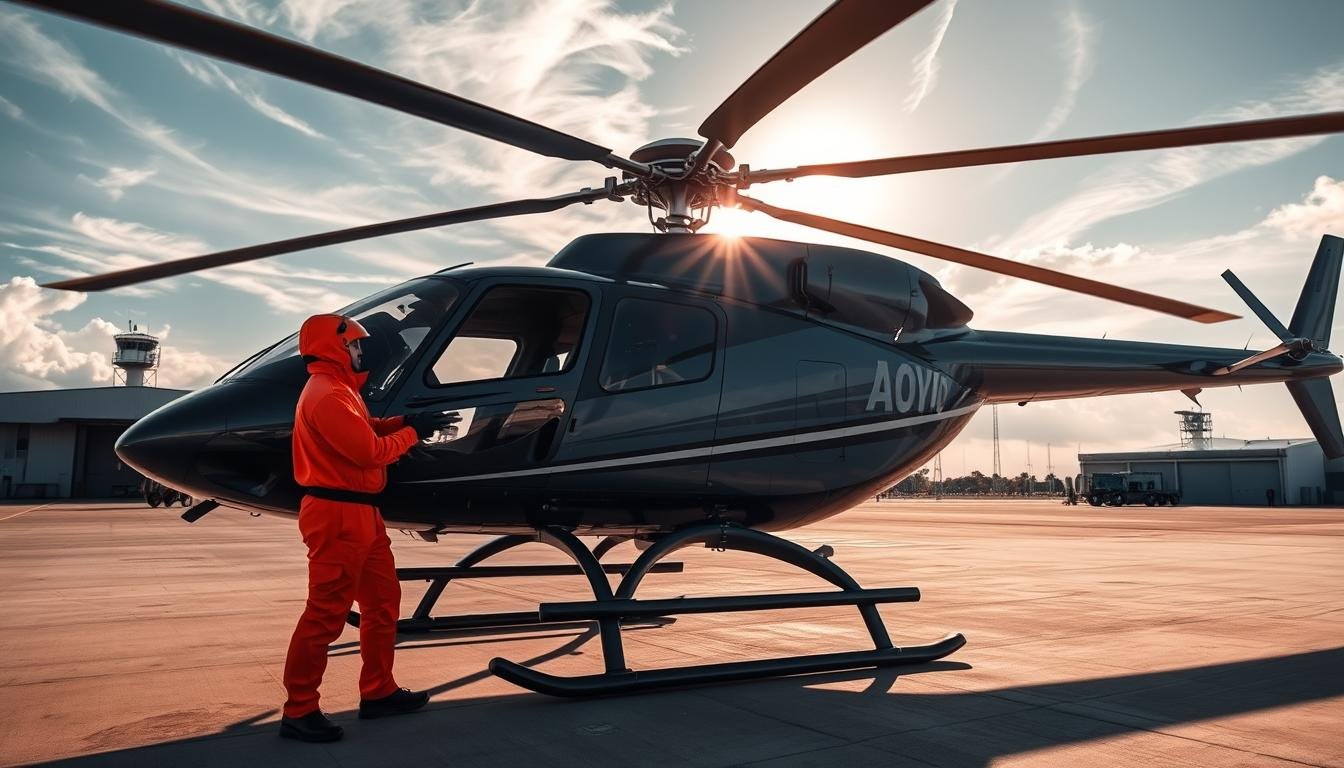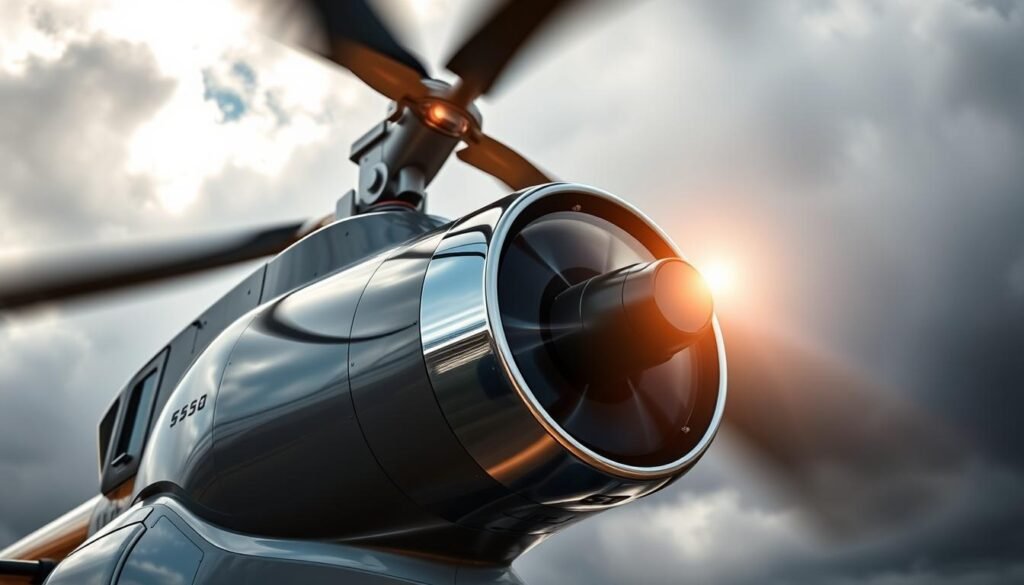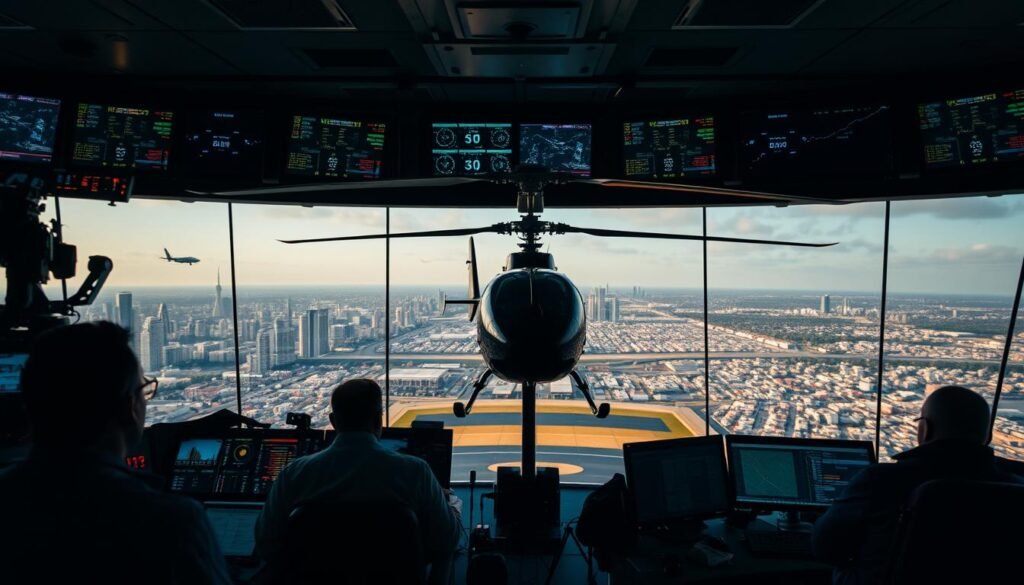One U.S. study found that rotorcraft now show fatal accident rates equal to or lower than many small fixed‑wing planes. That shift stems from better training, smarter systems, and stricter maintenance. Modern fleets use autopilot, collision‑avoidance tools, GPS, and health monitoring to cut risk.
The guide frames Helicopter Safety as practical steps crews use every day. Success is measured by a safe outcome, not keeping schedule. Habits and procedures matter more than luck for any mission.

Pilots and organizations should adopt standard flows, brief contingencies, and document limits before each flight. When training, systems, and maintenance work together, crews start with a conservative plan and verifiable aircraft status.
This article presents facts and trends first, then step‑by‑step methods to manage human errors and operational threats. For an operationally focused primer, see this practical guide on avoiding common pilot errors: how to avoid common pilot errors.
Key Takeaways
- Modern technology plus disciplined training lowers accident rates.
- Safe missions come from habits, procedures, and clear limits.
- Maintenance and health monitoring support proactive upkeep.
- Pilots must brief contingencies and apply standard flows.
- Focus on preventing human‑factor errors, not just equipment fixes.
Helicopter Safety Today: Facts, Risks, And What They Mean For Pilots
Recent multi‑year analyses paint a more balanced picture of rotorcraft risk than headlines imply. In the United States, the U.S. Helicopter Safety Team reports about 0.73 fatal accidents per 100,000 flight hours from 2019–2023. Commercial helicopters average roughly 3 million flight hours yearly with a similar rate near 0.77 for 2018–2022.
Understanding Current U.S. Accident Rates And Trends
When compared to small fixed‑wing aircraft, rotorcraft show competitive fatal rates per flight hour. The industry uses standardized denominators so pilots and managers can compare exposures fairly.
Why Weather, Mission Pressure, And Fatigue Still Drive Many Accidents
Data and expert commentary note that many accidents stem from decisions, not pure mechanical failure. Pilots who press into marginal weather, fight fatigue, or accept get‑it‑done bias raise the chance of an adverse event.
Operators and regulators reduce risk with focused training, clear go/no‑go rules, and reporting culture. Still, final mission decisions rest with the pilot, and conservative personal minimums remain the best defense against crashes and high‑visibility incidents.
How-To: Preflight Risk Management That Prevents In-Flight Surprises
Preflight planning that prioritizes forecasted conditions and aircraft status prevents many in‑flight surprises. This short workflow helps crews make clear, conservative decisions before accepting a mission.

Use A Weather-First Go/No-Go Flow With Clear Personal Minimums
Pilots adopt a weather‑first flow that sets ceilings, visibility, winds, and turbulence limits before loading. Cross‑check briefings with onboard instruments and external services.
Build A Mission Profile: Terrain, Payload, Fuel, And Alternate Landing Sites
Document terrain hazards, payload balance, power margins, and fuel reserves. Include alternates with known ground access and services. Plan conservative routing for high density‑altitude conditions.
Leverage Checklists, 100-Hour/Annual Maintenance Records, And HUMS Data
Verify logbook entries for 100‑hour and annual inspections and note deferred items or MEL constraints. Pull HUMS trends and compare to baselines to catch parts degradation before dispatch.
- Explicit fuel reserves for diversion, hover, and holding.
- Sterile‑cockpit brief for high‑workload phases and clear abort triggers.
- Confirm emergency gear, autorotation currency, and site selection criteria.
Release Standard: If systems, maintenance, or weather discrepancies cannot be mitigated, postpone or decline the mission to preserve operational safety.
Master In-Flight Decision-Making: Avoiding The Traps That Cause Crashes
When conditions deteriorate, timely choices and simple rules keep crews ahead of risk. John Goglia notes many crashes stem from crews pushing into marginal conditions to finish a mission, often while fatigued or distracted.

Fight “Get-The-Mission-Done” Bias With Time-Outs And Turn-Back Triggers
Brief clear turn-back and land-now triggers before takeoff. A preflight decision point defeats momentum and reduces confirmation bias.
- Set numeric limits for visibility, ceiling, or wind that force a turn back.
- Standardized callouts flag rising fatigue or narrowed attention so the crew can reset.
Manage Workload And Attention: Autopilot, Trim, And Task Prioritization
Pilots should call a time‑out when workload spikes. Use autopilot and trim to relieve basic control work while shedding nonessential tasks.
Verify mode status on coupled approaches and navigation overlays to avoid automation surprises.
Weather Deterioration Plays: Divert, Delay, Or Land—Early
Treat scud‑running and descent below safe altitudes as early warning signs. Diverting or landing early prevents many accidents.
Use short in‑flight risk checks at each phase to compare actual conditions to the plan and adjust route or timing.
Use Autorotation Proficiency And Forced-Landing Site Scanning
Continuous site scanning preserves the ability to transition to autorotation. Practiced autorotation skills turn a power loss into a manageable event.
| Trigger | Systems/Tool | Immediate Action |
|---|---|---|
| Visibility | Flight instruments, GPS overlay | Divert or land; brief turn-back |
| Workload spike | Autopilot, trim | Call time-out; shed tasks |
| Engine or warning event | HUMS, warning lights | Scan for landing site; prepare autorotation |
Recurrent training must drill turn-back decisions, autorotation precision, and clear crew communication so the right moves are automatic under pressure.
For operational context on pilot challenges and emergency practice see challenges faced by pilots and consult the technical review at operational primer.
Weather And Terrain: Flying Safely In Challenging Environments
Operations in degraded environments succeed when pilots combine practiced technique with well‑configured avionics.

Train For Low-Visibility, High-Wind, Icing, And Dust/Snow Operations
Structured training must include low‑visibility approaches, gust management around ridgelines, and brownout/whiteout drills.
Exercises cover power checks, escape routes, and stabilized approach criteria so the crew keeps control margins during noisy, gusty, or obscured conditions.
Practical icing sessions emphasize preheating, moisture assessment, and clear diversion points so crews know when equipment allows continued operations and when to divert.
Use Terrain And Traffic Tools: TAWS, Lidar/Radar, GPS, And Radio Altimeters
Configure TAWS, radar/lidar traffic cues, GPS overlays, and radio altimeters to create layered terrain and obstacle awareness.
Maintain sensor cleanliness and calibration as part of preflight maintenance to ensure systems perform to spec in marginal conditions.
| Hazard | Primary Tool | Immediate Crew Action |
|---|---|---|
| Low visibility | GPS overlays / radio altimeter | Use published minima; brief sterile cockpit |
| Brownout/whiteout | Visual references / stabilized approach | Apply approach geometry; execute go‑around if refs lost |
| High wind | Flight controls / escape route | Power check; fly to prebriefed escape |
Note: Firefighting and other high‑risk missions need higher margins due to heat, smoke, and turbulence. Conservative limits and alternates remain the primary controls, and advanced systems only augment crew judgment.
For guidance on how weather affects operations see weather impacts, and for practical tips consult top safety tips.
Helicopter Safety Through Training, Technology, And Maintenance Culture
Reducing in‑flight incidents depends on three pillars: recurrent training, advanced systems integration, and a maintenance culture that enforces standards.
This layered approach keeps crews and aircraft mission‑ready in the United States and abroad. It pairs simulators and scenario practice with avionics that assist—but do not replace—human judgment.

Continuous Training: Simulators, Scenario-Based IFR/VFR, And Recurrent Checks
Operators blend full‑motion simulators with scenario‑based IFR and VFR profiles. Recurrent checks focus on abnormal procedures, autorotation, and decision timing.
Track recency by task so the right pilot flies the right mission on the right day.
Advanced Systems: Collision Avoidance, Deicing, Adaptive Controls, And AI Aids
Modern systems include collision alerts, deicing systems, adaptive flight controls, and navigation automation. Standardized systems training prevents mode confusion and preserves crew awareness.
AI tools are framed as advisory aids that support, not supplant, the pilot’s authority.
Maintenance Discipline: FAA Intervals, Parts Quality, And Rapid Turnaround
Strict adherence to annual and 100‑hour inspections anchors maintenance culture. HUMS data drives condition‑based replacement of bearings and gearboxes.
Good parts traceability, scheduled ground time, and vendor audits keep turnaround fast without cutting inspection depth.
| Focus Area | Key Measure | Crew Action |
|---|---|---|
| Training | Simulator hours; recurrent check dates | Assign based on task recency; schedule instructor rides |
| Systems | Mode training; automation brief | Standardize callouts; run simulated failures |
| Maintenance | FAA intervals; HUMS trends; parts traceability | Hold ground time; replace on condition; audit vendors |
Conclusion
Consistent planning, clear limits, and steady training are the real reasons flights end well more often today.
Three Imperatives: Respect weather minima, fight mission pressure with predefined triggers, and keep airframes current with proper maintenance.
Pilots who brief alternates, manage workload, and act early avoid surprises and protect margins. Modern avionics and autorotation skills add resilience, but technology works best inside a conservative culture that values deliberate choices over schedule pressure.
Operators should embed these practices into SOPs, training, and audits and measure outcomes. For program-level guidance see FAA safety initiatives and review preflight inspections for practical checks before any flight.
FAQ
What are the leading causes of helicopter accidents in the United States today?
Major causes include adverse weather, pilot fatigue and mission pressure, maintenance lapses, and terrain-related controlled flight into terrain (CFIT). Human factors such as decision-making under stress and inadequate preflight risk assessment also contribute. Operators should track FAA accident data and implement targeted training and maintenance practices to reduce exposure.
How should a pilot structure a weather-first go/no-go decision process?
A weather-first flow begins with objective weather minima tied to the pilot’s certification and experience, then compares current and forecasted conditions against those minima. It includes personal limits for visibility, ceiling, winds, and icing potential, plus clear go/no-go triggers and mandatory diversion points. Use official sources like NOAA and ATC updates, and document the decision.
What preflight checks reduce the chance of in-flight surprises?
Combine a thorough checklist with a mission profile that covers weight and balance, fuel planning with reserves, alternate landing sites, expected terrain clearance, and system status. Verify 100-hour or annual maintenance records, inspect rotor systems, and review HUMS or engine trend monitoring data when available. Brief the crew on emergency procedures.
How can pilots prevent “get-the-mission-done” bias during critical flights?
Implement formal time-outs, predefined turn-back or divert triggers, and a decision matrix that overrides informal pressure. Encourage a safety culture where crew members can call for diversion without penalty. Use dispatch or operations support for objective second opinions when feasible.
What in-flight tools and techniques improve workload management and situational awareness?
Use autopilot and trim to reduce manual workload when appropriate, share tasks through clear cockpit resource management, and prioritize flying the aircraft first. Electronic flight bags, GPS, TAWS, and traffic advisory systems enhance situational awareness. Maintain sterile cockpit discipline during critical phases.
When should a pilot choose to divert, delay, or land early due to weather?
A pilot should divert, delay, or land as soon as conditions approach established personal minima, visibility drops, winds increase beyond control limits, or ice accumulation begins. Early conservative action preserves options and reduces the chance of controlled flight into terrain or loss of control in marginal conditions.
How often should crews train for autorotation and forced-landing scenarios?
Regular proficiency checks are essential. Training schedules should include recurrent autorotation practice during flight reviews and simulator sessions for emergency scenarios. Industry best practice recommends scenario-based recurrent checks at intervals defined by operator policies and FAA guidance.
What role do advanced systems play in reducing accident risk?
Technologies such as collision avoidance, deicing systems, adaptive flight controls, TAWS, lidar/radar terrain mapping, and AI-assisted decision aids reduce risk by improving detection, handling, and decision support. They do not replace good judgment; pilots must integrate tech outputs into sound risk management.
How can operators strengthen maintenance culture to prevent mechanical failures?
Enforce FAA intervals, use certified parts from reputable suppliers, maintain clear maintenance records, and act on trend monitoring from HUMS and engine data. Promote open reporting of defects, provide ongoing technician training, and ensure quick turnaround on critical repairs to avoid operational pressure that compromises quality.
What specific training helps pilots fly safely in low-visibility, high-wind, or icing conditions?
Scenario-based simulator training for IFR approaches, spatial disorientation recovery, and crosswind techniques is crucial. Ground school on icing recognition and avoidance, plus hands-on experience with deicing systems, prepares crews. Practice decision-making under pressure and emphasize conservative go/no-go choices.
How should mission planning account for terrain and payload constraints?
Build a mission profile that includes terrain clearance margins, payload effects on performance, density altitude calculations, and alternate landing sites. Use digital mapping, GPS routings, and weight-and-balance calculations to ensure safe performance margins throughout the flight.
What are effective fatigue-mitigation strategies for pilots on demanding missions?
Implement duty-time limits, enforce rest periods, schedule high-risk flights for optimal circadian periods, and use peer monitoring for signs of impairment. Operators should provide fatigue-management training and allow mission rescheduling without penalty when fatigue is present.g requires attention to detail and a commitment to following best practices. By recognizing and avoiding these common mistakes, pilots can enhance their safety and the safety of everyone on board.
Related Articles
- How to Avoid Common Helicopter Pilot Errors: A Guide to Safe Flying
- The Role of Air Traffic Control in Helicopter Safety
- Helicopter Safety in Bad Weather: Tips for Flying in Adverse Conditions
- How to Safely Land a Helicopter in Challenging Conditions
- The Importance of Proper Helicopter Maintenance for Flight Safety
More from This Category
- Understanding Helicopter Weight and Balance: Why It’s Crucial for Safe Flying
- Emergency Procedures in Helicopter Flights: How to Handle In-Flight Incidents
- Helicopter Pre-Flight Inspections: What Pilots Must Check Before Takeoff
- How to Prepare for Your First Helicopter Ride: Safety Procedures for Passengers
- Top 10 Helicopter Safety Tips Every Pilot Should Know



